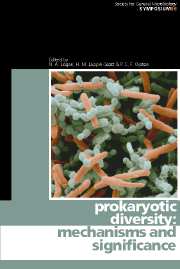Book contents
- Frontmatter
- Contents
- Contributors
- Editors' Preface
- Microbial diversity in the era of genomics
- Patterns in prokaryotic biodiversity
- A putative RNA-interference-based immune system in prokaryotes: the epitome of prokaryotic genomic diversity
- The significance of prokaryote diversity in the human gastrointestinal tract
- The genetics of phenotypic innovation
- Minimal genomes required for life
- Evolution of the core of genes
- Biogeographical diversity of archaeal viruses
- Is there a link between Chlamydia and heart disease?
- Unculturable oral bacteria
- Comparative genomics – what do such studies tell us about the emergence and spread of key pathogens?
- Spread of genomic islands between clinical and environmental strains
- Evolving gene clusters in soil bacteria
- Unusual micro-organisms from unusual habitats: hypersaline environments
- Genomic islands and evolution of catabolic pathways
- Horizontal gene transfer and its role in the emergence of new phenotypes
- Index
Horizontal gene transfer and its role in the emergence of new phenotypes
Published online by Cambridge University Press: 06 July 2010
- Frontmatter
- Contents
- Contributors
- Editors' Preface
- Microbial diversity in the era of genomics
- Patterns in prokaryotic biodiversity
- A putative RNA-interference-based immune system in prokaryotes: the epitome of prokaryotic genomic diversity
- The significance of prokaryote diversity in the human gastrointestinal tract
- The genetics of phenotypic innovation
- Minimal genomes required for life
- Evolution of the core of genes
- Biogeographical diversity of archaeal viruses
- Is there a link between Chlamydia and heart disease?
- Unculturable oral bacteria
- Comparative genomics – what do such studies tell us about the emergence and spread of key pathogens?
- Spread of genomic islands between clinical and environmental strains
- Evolving gene clusters in soil bacteria
- Unusual micro-organisms from unusual habitats: hypersaline environments
- Genomic islands and evolution of catabolic pathways
- Horizontal gene transfer and its role in the emergence of new phenotypes
- Index
Summary
INTRODUCTION
Introducing horizontal (or lateral) gene transfer (HGT) to first-year undergraduates used to be straightforward. A whistle-stop tour through the basic mechanisms of transformation, transduction and conjugation (with an honourable mention of homologous recombination) and descriptions of rough and smooth mutants of Streptococcus pneumoniae, the life cycles of phages lambda and T4 and the sexual proclivities of the ‘F’ factor was, until recently, little changed over the intervening years since their discovery. These processes (described in more detail below) also form the cornerstone of much of bacterial genetics, albeit from a predominantly Escherichia coli-centric perspective. This year celebrates the sixtieth anniversary of Joshua Lederburg and Edward Tatum's groundbreaking discovery of sexual transfer in bacteria (Lederburg & Tatum, 1946), yet to many the concept of HGT as a driving force in evolution has only come of age with the advent of comparative genomics (Kurland, 2000), which has revealed that far more is involved in HGT than plasmid-mediated conjugation. This review begins by providing an overview of the significance of HGT, defined here as ‘the acquisition and stable maintenance of foreign DNA into the genome of a recipient cell’ and introduces the key mobile genetic elements (MGEs) that are the agents of HGT. The roles of comparative genomics and bioinformatics and of the emerging field of metagenomics are discussed in relation to changes in perception of the significance of HGT in prokaryotic evolution, and the review concludes by highlighting key examples of recently recognized HGT-mediated phenotypes in the prokaryotic world.
- Type
- Chapter
- Information
- Prokaryotic DiversityMechanisms and Significance, pp. 275 - 294Publisher: Cambridge University PressPrint publication year: 2006
- 1
- Cited by



